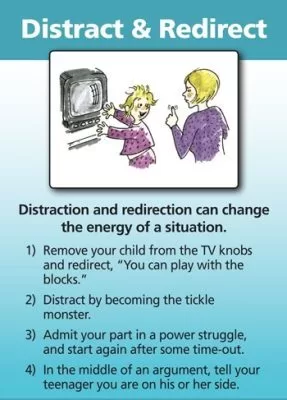REDIRECTION

Redirection is a technique that parents can use to help children understand what appropriate behavior is and how to manage their behaviors. Redirection is used to promote desirable behavior, prevent injury, reduce punishment, and promote learning and exploration.
REDIRECTION – TODDLERS
Toddlers do not understand what the word “no” means and why they cannot engage in certain behaviors. Parents must show children at this age what appropriate behavior is.
For instance, if a child hits, the parent can redirect the child to another topic, location, or activity. Parents can redirect the behavior by getting out crafts or a game the child enjoys. Parents can also ask leading questions to redirect the misbehavior. For example, parents can ask what they want to do later in the day

REDIRECTION – 5-10 YEAR OLDS
Explain the impact that their behavior has on others.
Explain why the rules are in place.
Encourage the child to use independent problem–solving skills. Rather than
simply saying “no” or correcting the child, teach them prevention strategies. For
instance, talk about a situation where the child behaved inappropriately and
discuss better solutions.
For older children, they may do well with options. For example,
children might refuse to complete their homework because they want to play
outside and watch television. The parent can let the child chose which activity
he/she wants to drop (either watching TV or playing outside) so that they can
complete the homework.

REDIRECTION – TEENAGERS
Before talking to your teen remember this:
The teenage brain is not fully developed, so they may not see the risks and consequences as you do.
Be flexible. This may make them more willing to listen and talk about the conflict. If you overreact or lose control, simply apologize. Discuss conflict when you are not angry or upset. Prepare what you will say beforehand
When talking with your teen remember this:
Choose a location where you will not get interrupted or distracted.
Remain calm and listen to them. Let them express their point of view. Express your own feelings. Be honest.
Compromise when possible. If you say “no,” make sure to do it calmly.
